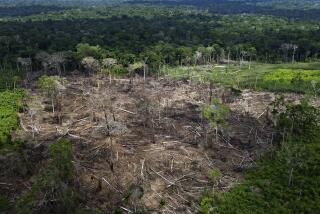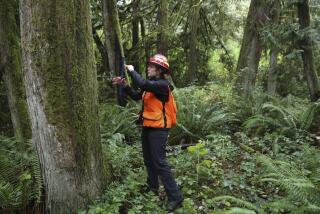Botanist Reiterates Warning: Look to Tropics to See How We Are Killing Our World
- Share via
CHICAGO — Many people have heard it before, but a renowned botanist contends that the message does not appear to be sinking in.
The message: We are killing our world, destroying rain forests the size of Kansas every year and driving an average of 100 species into extinction every day.
A burgeoning tropical population and foolish exploitation of resources continue to eat away at the global ecosystem at a rate that will see the virtual elimination of forests in the next 60 years and the extinction of 1.1 million species by the year 2020.
‘Losing Opportunity’
“Scientifically, we are losing the opportunity to understand the nature of much of the diversity of life on Earth,” said Peter H. Raven, director of the Missouri Botanical Garden and professor of botany at Washington University in St. Louis.
“Aesthetically, we are losing the chance to appreciate fully the results of the process of evolution over the billions of years since life appeared on our planet,” he said. “Economically, we are denying to ourselves, our children and our grandchildren the opportunity to utilize many of the plants, animals and microorganisms that exist now for their benefit.”
Raven gave the keynote address on this topic at the annual meeting of the American Assn. for the Advancement of Science recently.
“I know people are getting awfully tired of hearing about this,” Raven said in an interview. “Unfortunately, the problem hasn’t gone away.”
Recipient of Genius Grant
Raven, a 1985 recipient of a no-strings-attached genius grant by the MacArthur Foundation, cited several factors as contributing to the mass extinction:
- A tropical population explosion continues to outpace population growth elsewhere on the planet, and within 40 years nearly two-thirds of the 8 billion people on the planet will live in the tropics. In 1950, there were only 2.5 billion people, 45% of whom were tropical inhabitants.
- The immensity of the burgeoning tropical population has only been matched by its lack of resources, with 1 billion of the 2.7 billion people now living there in abject poverty. The per capita income in Africa and Latin America--now about a tenth of that found in industrialized countries--is steadily declining.
- The growing number of poor, coupled with ignorance about proper cultivation and land management, has led to the clearing or destruction of 80,000 square miles of tropical, lowland, evergreen forests every year. “We’re losing (the equivalent of) Kansas every year,” Raven said. At that rate, all of the tropical forests will be gone in 30 years, he said.
- Of an estimated 4.5 million forms of life that are believed to exist on the planet, 2.2 million live in those same tropical forests. Most of these species are not highly adaptable, and conservatively speaking, only half of them will survive if their habitat is destroyed.
Species Headed for Extinction
This means that 1.1 million species of plant and animal life will be extinct by 2020, an average of 100 becoming extinct per day. That is about 1,000 times the extinction rate naturally expected.
Raven said that although his predictions may not come true, “this is not a worst-case scenario and is likely to happen if the appropriate steps aren’t taken.” He suggested that only with appropriate financial and educational support can developing countries learn to cultivate rather than destroy their resources.
“This is the point--what we do right now is very important,” he said.






